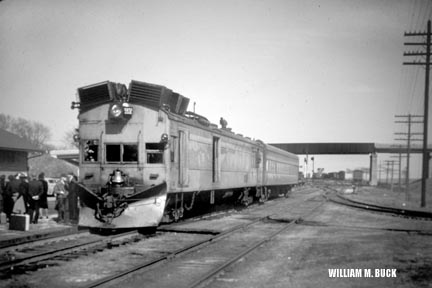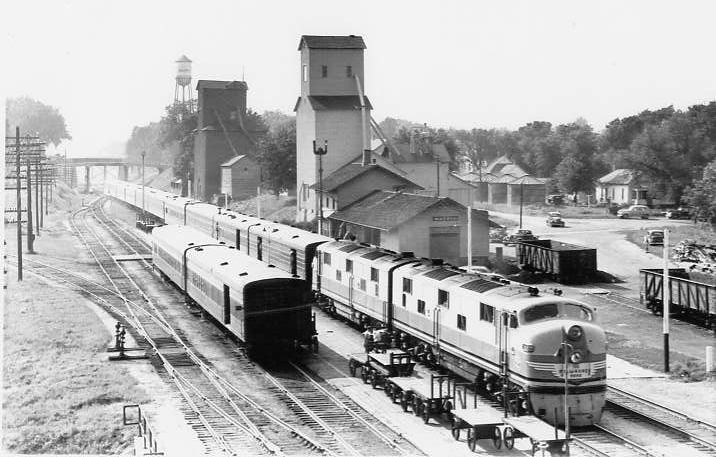
The afternoon arrival of the Hiawatha in to Madrid
Courtesy of Stewart Buck

Connected passengers from Madrid to Boone
Courtesy of Stewart Buck
“Tracks of My Life”
One of my earliest childhood memories takes me back to the cobalt blue skies of a summer’s twilight, as I drift off to sleep listening to the sound of my Dad’s big bands records. “Moonlight Serenade” “Solitude,” “Mood Indigo” and “Sentimental Journey” waft through the house, intermittently punctuated by another sound coming in through my bedroom window. It was the melodious call of steam locomotive whistles echoing through the valley and lingering in the gathering darkness. The reason trains had such a profound impact on me so early in my life was because of my Dad. He loved trains and he passed that passion on to me. Like the fireman who shovels coal to build up steam, Dad was the one who fueled my enthusiasm for trains.
A favorite childhood activity was Dad taking my two brothers and me to the Ames depot to watch the arrival of the westbound Challenger. While waiting for the streamliner, Dad would regale us with stories about great trains that ran through Ames, like the Gold Coast, the San Francisco Overland, the Los Angeles Limited, the Forty Niner, the Corn King, the Columbine, the Portland Rose, and the City of Denver. Dad described what it was like, as an impressionable young lad, to stand on the Ames depot platform watching the mighty steam locomotives, like his favorite Class H 4-8-4’s and the sleek 4-6-4 E-4 streamlined Hudsons, as they thundered away from Ames depot pulling flashy express trains.
Dad told us about the first diesel Streamliner, which began service in 1934. The train came through Ames westbound around 10:30 PM. The Streamliner had an airhorn instead of a steam whistle, so it was easy for him to tell it from the rest of the trains of that time. Although he lived a mile away from the mainline on Oakland Street, he could still follow the train’s progress by observing its vertical warning light. The light was used to alert motorists and could be seen shooting into the night sky as the train went westward towards Boone. He knew when the train went under what is now called the Minnesota Avenue overpass (directly north of his house), because the light was momentarily snuffed out as the train passed under the bridge.
He also would tell us about his Mom taking him to Ames’ western suburb of Ontario to watch westbound freight trains as they thundered up College Hill, heaving a volcanic pillar of smoke into the sky. As a child, he was both enthralled and terrified as the passing locomotive would shake the earth and leave a shower of soot and cinders dropping to his feet.
When Dad was ten years old, his passion for trains blossomed when he received from his father a standard gauge American Flyer electric train with a locomotive and four passenger cars. He assembled the train in the attic of his home by nailing the tracks down to the hardwood floor. A little less than twenty years later, he purchased the first American Flyer train for his sons. He constructed a train table from two sheets of 4 x 8 plywood and from there grew the little town of Plasticville, where miniature trains puffed and whistled all day long. Over the years, the little town of Plasticville grew, as did the interest Dad and I shared.
One of Dad’s favorite times to view trains was while serving as a captain in military service, providing dental care at the Strategic Air Command’s Air Force Base in Amarillo, Texas. There he was able to spend his weekends at the Santa Fe depot, where he observed monstrous 2-10-4’s and 4-8-4’s, as well as the striking warbonnet F-units and Alco PA’s that pulled ATSF’s famous stainless steel passenger trains. At the military base, he developed a new interest in jet airplanes. There he observed both the T-33 T-Birds and the new high-altitude subsonic bombers, the B-47 Stratojets. One of the big thrills of Dad’s life was the opportunity to a ride on one of the six engine B-47’s. He never forgot that experience and when he reached his mid-50’s, he became pilot. While Dad was getting hours of flight time to obtain his private license, he and I would railfan by flying over various railroad yards and following rail lines.
Indelibly etched in Dad’s mind was an exhilarating trip he took on Chicago and North Western’s steam powered 400. He was awestruck by its speed, especially how it rocketed out of Chicago and within minutes was pushing the century mark. He spent lots of time riding trains when he traveled between Ames and Iowa City, where he was attending Dentistry School at the University of Iowa. He would usually take the Eagle Grove to Des Moines train out of Ames to the C&NW’s depot on the east side of the river in downtown Des Moines. The train usually consisted of three or four heavyweight coaches pulled by a Class D Atlantic. He would walk several blocks to the Rock Island depot, and catch whatever convenient train he could to Iowa City. If he was lucky, it would be one of the Rockets. On the way back from Iowa City, he would usually take the CRANDIC interurban to downtown Cedar Rapids. It would drop him off just a short distance from the C&NW depot. There he’d try to catch one of the City Streamliners for Ames. Quite often, there wasn’t a coach seat for him, so the conductor would send him to one of the club cars. His favorite was the Frontier Shack on the City of Denver. The interior of the Frontier Shack was unfinished pine boards, with the floor made of unmatched scrub oak. It had kerosene lamps, a mahogany bar, mounted animal heads, rifles, horn racks, old posters, and period maple furniture. Passengers were encouraged to carve their initials into the tables, which Dad did. Many years later, when I was very young, our family rode into Chicago on the City of Denver. Train #112 still had the Frontier Shack in it’s consist and Dad was quite amazed to see his initials were still visible in the table.
Dad and I spent spend countless hours walking along railroad together. Like the tracks we walked on, Dad provided me with a rock solid foundation to guide me through life. He provided the “tracks of my life.” Like the train-whistle echoing through the valley, Dad’s gentle guiding spirit and memory will linger on in me forever.

Madrid has had a history of trains and mining.
The sounds of the great engines has long passed as have the tracks and train station in the last decade.
We thank Mr. Buck for his story of a father and son's love for trains and how that story could have taken place in Madrid.
September 24, 1924 - March 29, 2007